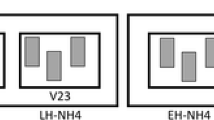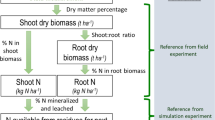Abstract
Development and use of models to predict and study the production and the environmental impacts of biomass cropping systems are of great interest for their sustainable development. Improvements were made to the research version of the STICS crop–soil model in order to simulate biomass production and environmental impacts of Miscanthus × giganteus cropping systems in the long term. This research version was then validated on a large database and in various pedoclimatic environments in France and UK. The model accurately simulated biomass production and nitrogen (N) content in aboveground biomass, from planting until 4 to 20 years of cultivation. The model efficiency (EF) was 0.80 and 0.64 for biomass and N content, respectively, and the values of relative RMSE were 23 and 31 %. Soil water and mineral N contents were also satisfactorily predicted (EF = 0.96 and 0.42; relative RMSE = 10 and 72 %). The model accurately reproduced the effect of management practices on the harvested biomass and N export. Yield gap analysis using simulations with and without active stresses revealed that Miscanthus × giganteus biomass production was limited by both water and N availability during the establishment phase but mainly limited by water availability during the post-establishment phase. The STICS crop–soil model can accurately predict Miscanthus × giganteus biomass production and environmental impacts such as water drainage and nitrate leaching and compare strategies with varying N fertilization, irrigation and harvest date.






Similar content being viewed by others
References
Lewandowski I, Clifton-Brown JC, Scurlock JMO, Huisman W (2000) Miscanthus: European experience with a novel energy crop. Biomass Bioenergy 19(4):209–227
Christian DG, Haase E (2001) Agronomy of Miscanthus. In: Jones MB, Walsh ME (eds) Miscanthus for energy and fibre. James & James, London, pp 21–45
Heaton E, Voigt T, Long SP (2004) A quantitative review comparing the yields of two candidate C 4 perennial biomass crops in relation to nitrogen, temperature and water. Biomass Bioenergy 27(1):21–30. doi:10.1016/j.biombioe.2003.10.005
Cosentino SL, Patane C, Sanzone E, Copani V, Foti S (2007) Effects of soil water content and nitrogen supply on the productivity of Miscanthus giganteus Greef et Deu. in a Mediterranean environment. Ind Crop Prod 25(1):75–88. doi:10.1016/j.indcrop.2006.07.006
Ercoli L, Mariotti M, Masoni A, Bonari E (1999) Effect of irrigation and nitrogen fertilization on biomass yield and efficiency of energy use in crop production of Miscanthus. Field Crop Res 63(1):3–11. doi:10.1016/s0378-4290(99)00022-2
Cadoux S, Riche AB, Yates NE, Machet J-M (2012) Nutrient requirements of Miscanthus × giganteus: conclusions from a review of published studies. Biomass Bioenergy 38:14–22. doi:10.1016/j.biombioe.2011.01.015
Miguez FE, Villamil MB, Long SP, Bollero GA (2008) Meta-analysis of the effects of management factors on Miscanthus × giganteus growth and biomass production. Agric For Meteorol 148(8/9):1280–1292. doi:10.1016/j.agrformet.2008.03.010
Lewandowski I, Schmidt U (2006) Nitrogen, energy and land use efficiencies of Miscanthus, reed canary grass and triticale as determined by the boundary line approach. Agric Ecosyst Environ 112(4):335–346. doi:10.1016/j.agee.2005.08.003
Lobell DB, Cassman KG, Field CB (2009) Crop yield gaps: their importance, magnitudes, and causes. Annual Review of Environment and Resources, vol 34. Annual Review of Environment and Resources. Annual Reviews, Palo Alto, pp 179–204. doi:10.1146/annurev.environ.041008.093740
Bhatia VS, Singh P, Wani SP, Chauhan GS, Rao A, Mishra AK, Sriniuas K (2008) Analysis of potential yields and yield gaps of rainfed soybean in India using CROPGRO-Soybean model. Agric For Meteorol 148(8–9):1252–1265. doi:10.1016/j.agrformet.2008.03.004
Clifton-Brown JC, Neilson B, Lewandowski I, Jones MB (2000) The modelled productivity of Miscanthus × giganteus (GREEF et DEU) in Ireland. Ind Crop Prod 12(2):97–109. doi:10.1016/s0926-6690(00)00042-x
Hastings A, Clifton-Brown J, Wattenbach M, Mitchell P, Smith P (2009) The development of MISCANFOR, a new Miscanthus crop growth model: towards more robust yield predictions under different climatic and soil conditions. Glob Change Biol Bioenergy 1(2):154–170. doi:10.1111/j.1757-1707.2009.01007.x
Jing Q, Conijn SJG, Jongschaap REE, Bindraban PS (2012) Modeling the productivity of energy crops in different agro-ecological environments. Biomass Bioenergy 46:618–633. doi:10.1016/j.biombioe.2012.06.035
Miguez FE, Zhu XG, Humphries S, Bollero GA, Long SP (2009) A semimechanistic model predicting the growth and production of the bioenergy crop Miscanthus × giganteus: description, parameterization and validation. Glob Change Biol Bioenergy 1(4):282–296. doi:10.1111/j.1757-1707.2009.01019.x
Ng TL, Eheart JW, Cai XM, Miguez F (2010) Modeling miscanthus in the Soil and Water Assessment Tool (SWAT) to simulate its water quality effects as a bioenergy crop. Environ Sci Technol 44(18):7138–7144. doi:10.1021/es9039677
Pogson M (2011) Modelling Miscanthus yields with low resolution input data. Ecol Model 222(23–24):3849–3853. doi:10.1016/j.ecolmodel.2011.10.008
Stričević R, Dželetović Z, Djurović N, Cosić M (2014) Application of the AquaCrop model to simulate the biomass of Miscanthus × giganteus under different nutrient supply conditions. GCB Bioenergy. doi:10.1111/gcbb.12206
Strullu L, Beaudoin N, Garcia de Cortazar-Atauri I, Mary B (2014) Simulation of biomass and nitrogen dynamics in perennial organs and shoots of Miscanthus × giganteus using the STICS model. BioEnerg Res 7(4):1253–1269. doi:10.1007/s12155-014-9462-4
Trybula EM, Cibin R, Burks JL, Chaubey I, Brouder SM, Volenec JJ (2014) Perennial rhizomatous grasses as bioenergy feedstock in SWAT: parameter development and model improvement. GCB Bioenergy. doi:10.1111/gcbb.12210
Brisson N, Launay M, Mary B, Beaudoin N (2008) Conceptual basis, formalisations and parameterization of the stics crop model. Quae, Versailles
Coucheney E, Buis S, Launay M, Constantin J, Mary B, García Cortázar-Atauri I, Ripoche D, Beaudoin N, Ruget F, Andrianarisoa KS, Le Bas C, Justes E, Léonard J (2015) Accuracy, robustness and behavior of the STICS soil–crop model for plant, water and nitrogen outputs: evaluation over a wide range of agro-environmental conditions in France. Environ Model Softw 64:177–190. doi:10.1016/j.envsoft.2014.11.024
Wedin DA, Tilman D (1990) Species effects on nitrogen cycling—a test with perennial grasses. Oecologia 84(4):433–441
Brisson N, Mary B, Ripoche D, Jeuffroy MH, Ruget F, Nicoullaud B, Gate P, Devienne-Barret F, Antonioletti R, Durr C, Richard G, Beaudoin N, Recous S, Tayot X, Plenet D, Cellier P, Machet JM, Meynard JM, Delecolle R (1998) STICS: a generic model for the simulation of crops and their water and nitrogen balances. I. Theory and parameterization applied to wheat and corn. Agronomie 18(5–6):311–346
De Wit (1978) Simulation of assimilation, respiration and transpiration of crops. Pudoc, Wageningen
Pages L, Becel C, Boukcim H, Moreau D, Nguyen C, Voisin AS (2014) Calibration and evaluation of ArchiSimple, a simple model of root system architecture. Ecol Model 290:76–84. doi:10.1016/j.ecolmodel.2013.11.014
Riche A, Christian DG (2001) Estimates of rhizome weight of Miscanthus with time and rooting depth compared to switchgrass. Aspects of Applied Biology 65 (Biomass and energy Crops II)
Ferchaud F, Vitte G, Mary B Belowground biomass and root distribution of two perennial biomass crops in a deep loamy soil. 4th International Congress EUROSOIL 2012, Bari, Italy, ate 2012. ECSSS, p 1983
Ferchaud F, Vitte G, Bornet F, Strullu L, Mary B (2015) Soil water uptake and root distribution of different perennial and annual bioenergy crops. Plant and Soil 388:307–322. doi:10.1007/s11104-014-2335-y
Mary B, Beaudoin N, Justes E, Machet JM (1999) Calculation of nitrogen mineralization and leaching in fallow soil using a simple dynamic model. Eur J Soil Sci 50(4):549–566
Wang EL, Engel T (1998) Simulation of phenological development of wheat crops. Agric Syst 58(1):1–24. doi:10.1016/s0308-521x(98)00028-6
Christian DG, Riche AB, Yates NE (2008) Growth, yield and mineral content of Miscanthus × giganteus grown as a biofuel for 14 successive harvests. Ind Crop Prod 28(3):320–327. doi:10.1016/j.indcrop.2008.02.009
Strullu L, Cadoux S, Preudhomme M, Jeuffroy MH, Beaudoin N (2011) Biomass production and nitrogen accumulation and remobilisation by Miscanthus × giganteus as influenced by nitrogen stocks in belowground organs. Field Crop Res 121(3):381–391. doi:10.1016/j.fcr.2011.01.005
Loague K, Green RE (1991) Statistical and graphical method for evaluating solute transport models: overview and application. J Contam Hydrol 7:51–73
Willmott CJ (1981) On the validation of models. Phys Geogr 2(2):184–194. doi:10.1080/02723646.1981.10642213
Clifton-Brown JC, Breuer J, Jones MB (2007) Carbon mitigation by the energy crop, Miscanthus. Glob Chang Biol 13(11):2296–2307. doi:10.1111/j.1365-2486.2007.01438.x
Gauder M, Graeff-Honninger S, Lewandowski I, Claupein W (2012) Long-term yield and performance of 15 different Miscanthus genotypes in southwest Germany. Ann Appl Biol 160(2):126–136. doi:10.1111/j.1744-7348.2011.00526.x
Lewandowski I, Heinz A (2003) Delayed harvest of Miscanthus—influences on biomass quantity and quality and environmental impacts of energy production. Eur J Agron 19(1):45–63. doi:10.1016/s1161-0301(02)00018-7
Jorgensen U (1997) Genotypic variation in dry matter accumulation and content of N, K and Cl in Miscanthus in Denmark. Biomass Bioenergy 12(3):155–169. doi:10.1016/s0961-9534(97)00002-0
Yu L, Ding G, Huai Z, Zhao H (2013) Natural variation of biomass yield and nutrient dynamics in Miscanthus. Field Crop Res 151:1–8. doi:10.1016/j.fcr.2013.07.001
Yang JD, Worley E, Wang MY, Lahner B, Salt DE, Saha M, Udvardi M (2009) Natural variation for nutrient use and remobilization efficiencies in switchgrass. Bioenergy Res 2(4):257–266. doi:10.1007/s12155-009-9055-9
Amougou N, Bertrand I, Machet JM, Recous S (2011) Quality and decomposition in soil of rhizome, root and senescent leaf from Miscanthus × giganteus, as affected by harvest date and N fertilization. Plant Soil 338(1/2):83–97. doi:10.1007/s11104-010-0443-x
Foereid B, de Neergaard A, Hogh-Jensen H (2004) Turnover of organic matter in a Miscanthus field: effect of time in Miscanthus cultivation and inorganic nitrogen supply. Soil Biol Biochem 36(7):1075–1085. doi:10.1016/j.soilbio.2004.03.002
Christian DG, Poulton PR, Riche AB, Yates NE, Todd AD (2006) The recovery over several seasons of 15N-labelled fertilizer applied to Miscanthus × giganteus ranging from 1 to 3 years old. Biomass Bioenergy 30(2):125–133. doi:10.1016/j.biombioe.2005.11.002
Strullu L, Cadoux S, Beaudoin N, Jeuffroy MH (2013) Influence of belowground nitrogen stocks on light interception and conversion of Miscanthus × giganteus. Eur J Agron 47:1–10. doi:10.1016/j.eja.2013.01.003
Danalatos NG, Archontoulis SV, Mitsios I (2007) Potential growth and biomass productivity of Miscanthus × giganteus as affected by plant density and N-fertilization in central Greece. Biomass Bioenergy 31(2/3):145–152. doi:10.1016/j.biombioe.2006.07.004
Himken M, Lammel J, Neukirchen D, CzypionkaKrause U, Olfs HW (1997) Cultivation of Miscanthus under west European conditions: seasonal changes in dry matter production, nutrient uptake and remobilization. Plant Soil 189(1):117–126
Davis SC, Parton WJ, Dohleman FG, Smith CM, Grosso SD, Kent AD, Delucia EH (2010) Comparative biogeochemical cycles of bioenergy crops reveal nitrogen-fixation and low greengouse gas emissions in a Miscanthus × giganteus agro-ecosystem. Ecosystems 13:144–156. doi:10.1007/s10021-009-9306-9
Eckert B, Weber OB, Kirchhof G, Halbritter A, Stoffels M and Hartmann A (2001) Azospirillum doebereinerae sp. Nov., a nitrogen-fixing bacterium associated with the C4-grass Miscanthus. IJSEM (51):17–26. doi:10.1099/00207713-51-1-17
Zub HW, Brancourt-Hulmel M (2010) Agronomic and physiological performances of different species of Miscanthus, a major energy crop. A review. Agron Sustain Dev 30(2):201–214. doi:10.1051/agro/2009034
Roncucci N, Nassi O, Di Nasso N, Bonari E, Ragaglini G (2014) Influence of soil texture and crop management on the productivity of miscanthus (Miscanthus × giganteus Greef et Deu.) in the Mediterranean. GCB Bioenergy. doi:10.1111/gcbb.12202
Acknowledgments
The authors thank the different contributors to the data set which allowed model parameterization and validation: partners of the ‘Lignoguide’ CasDar project (Chambre d’Agriculture Picardie, AgroTransfert RT, ARVALIS – Institut du Végétal, AXEREAL, CA Aisne, CA Loiret, CA Oise), CA Marne (P. Wortham) for the Saint-Hilaire site and INRA URP3F for the Lusignan site. We also thank Météo France for providing climatic data. This study has been funded under the EU seventh Framework Programme by the LogistEC project no. 311858: Logistics for Energy Crops’ Biomass. The views expressed in this work are the sole responsibility of the authors and do not necessary reflect the views of the European Commission. Rothamsted Research receives grant-aided support from the BBSRC.
Author information
Authors and Affiliations
Corresponding author
Electronic supplementary material
Below is the link to the electronic supplementary material.
Online Resource 1
Observed and simulated values for different variables concerning M. giganteus root system at Estrées-Mons in 2010. (DOCX 16 kb)
Online Resource 2
Observed yield and N concentration in aboveground organs at harvest of M. giganteus in two experiments located in Rothamsted. (DOCX 21 kb)
Rights and permissions
About this article
Cite this article
Strullu, L., Ferchaud, F., Yates, N. et al. Multisite Yield Gap Analysis of Miscanthus × giganteus Using the STICS Model. Bioenerg. Res. 8, 1735–1749 (2015). https://doi.org/10.1007/s12155-015-9625-y
Published:
Issue Date:
DOI: https://doi.org/10.1007/s12155-015-9625-y




